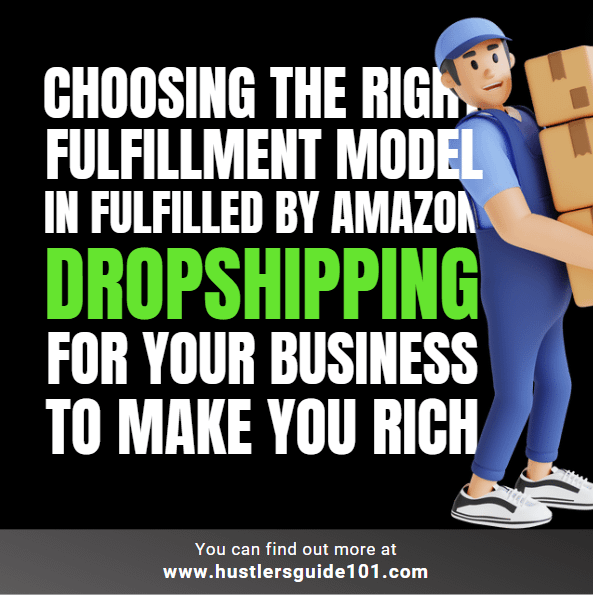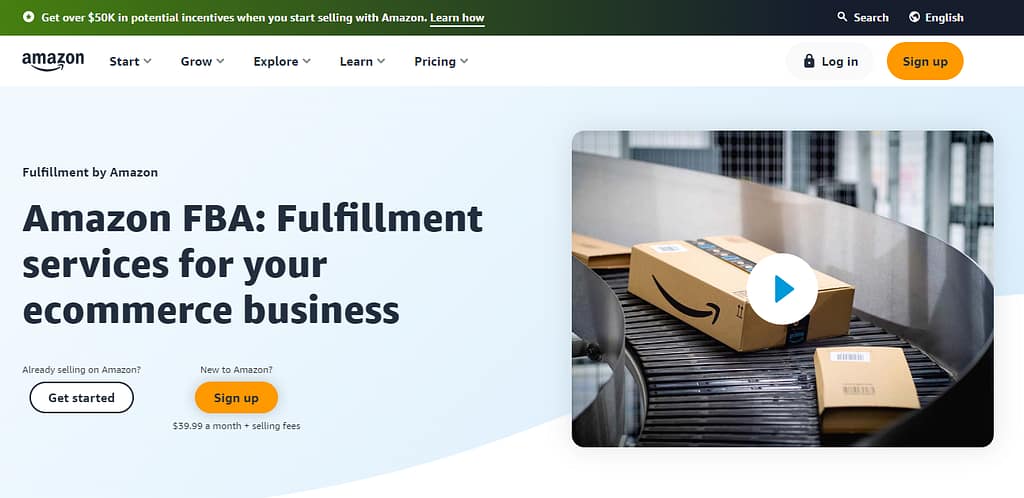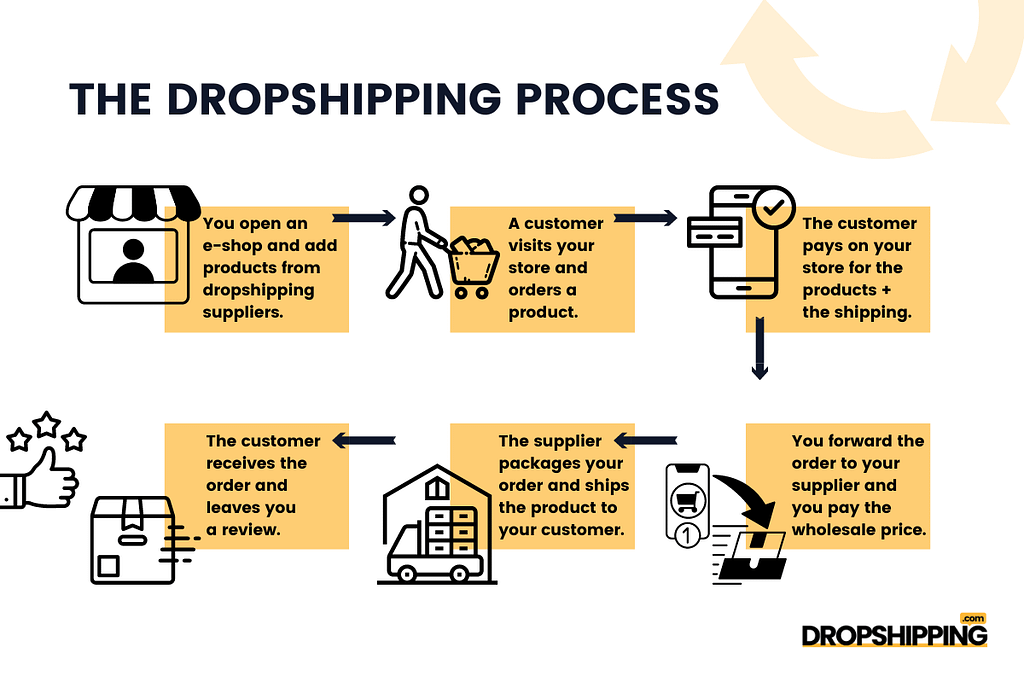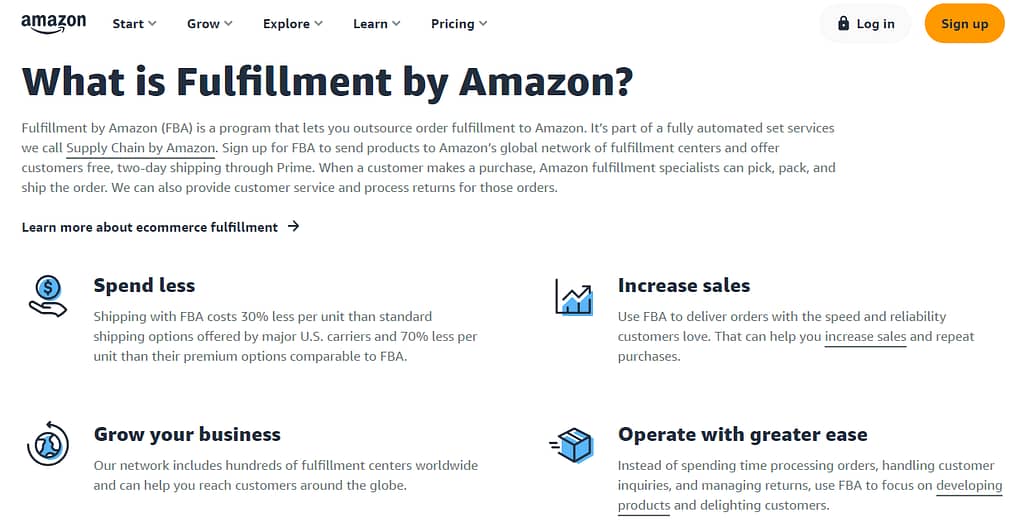
Amazon FBA (Fulfillment by Amazon) allows sellers to use Amazon’s vast infrastructure, including warehousing, packaging, and shipping. Dropshipping enables entrepreneurs to sell products without ever handling the inventory themselves and relying on suppliers who handle the logistics. Which one to choose? Amazon FBA vs Dropshipping: A detailed guide to clear all your queries.
I will explain each model’s pros and cons and delve into crucial factors like startup costs, scalability, control over branding, and customer experience.
From profit margins and fulfillment efficiency to market saturation and competition, I will target the key elements that determine your success in the world of e-commerce.
What Is Amazon FBA?
Amazon’s FBA program allows sellers to enjoy Amazon’s vast infrastructure for their e-commerce businesses. And by enjoy, I mean avail of the perks and boost their business.
With FBA, sellers can store their products in Amazon’s warehouses, and when an order is placed, Amazon takes care of packaging and shipping the products to the customers, so it’s not your headache.
This streamlined process enables sellers to focus on other aspects of their businesses, such as marketing and customer service, while still enjoying a good weekend.
How Amazon FBA Works?
Inventory Storage: You, being a seller, purchase your products in bulk and ship them to Amazon fulfillment centers strategically located around the globe.
Order Fulfillment: When a customer places an order on your Amazon listing, Amazon picks, packs, and ships the product directly to the customer.
Customer Service: Amazon handles most customer service inquiries, including returns and refunds, of course, with some exceptions and conditions.

What is Dropshipping?
Dropshipping is another e-commerce model that has gained popularity in recent years. Unlike Amazon FBA, dropshipping does not require sellers to hold inventory. Instead, sellers partner with suppliers who handle the logistics of storing, packaging, and shipping the products directly to the customers.
The seller’s role is primarily focused on marketing and driving sales. Breaking down the concept: Dropshipping is a fulfillment method where the seller partners with a third-party supplier who holds the inventory and handles shipping directly to their customers.
Print-on-demand and dropshipping, can they work together? Find out yourself.
How Does Dropshipping Work?
Product Listing: You list products on your online store or marketplace platform.
Order Processing: Once a customer places an order, you forward the order details and shipping information to your dropshipping supplier.
Supplier Fulfillment: The supplier picks, packs, and ships the product under your brand name to your customer.

If the dropshipping business seems interesting and profitable to you, do check out Is Temu Dropshipping Profitable In 2024? Or you can also read Amazon Dropshipping vs Shopify Dropshipping.
Comparison of Amazon FBA vs Dropshipping
When comparing Amazon FBA and dropshipping, several key factors come into play. Just so you know, Amazon FBA is suitable when you have the capital to invest in inventory and prioritize fast shipping and customer service.
On the contrary, Dropshipping is suitable when you start with a limited budget, want to test different product ideas and prioritize control over your branding. Let’s explore these factors to understand the strengths and weaknesses of each e-commerce model.
1. Costs
In terms of costs, you can see that dropshipping has a clear advantage. With no upfront investment in inventory, sellers can avoid the expenses associated with purchasing, storing, and managing stock.
However, dropshipping does have its own costs, such as marketing, website maintenance, and customer acquisition. On the other hand, Amazon FBA has fees associated with using the program, including storage and fulfillment fees.
Although the costs are not very high, a chunk of small investments turn into big investments. These costs can eat into profit margins, especially for products with low price points. Ouch!
These costs can vary depending on the size and weight of the products being sold. However, this makes dropshipping an attractive option for beginners who want to test the waters of e-commerce without a substantial financial commitment.
Warning: Products will be shipped in Amazon packaging, limiting your branding opportunities. Plus the sheer number of sellers on Amazon can make it challenging to stand out.
2. Control
Control over the fulfillment process and customer experience is important to have some space and liberty in your business. With Amazon FBA, sellers have less control over the logistics, as everything is handled by Amazon.
Conversely, dropshipping allows sellers to have more control over the customer experience. They can work directly with suppliers and make decisions regarding packaging and shipping.
I think this can be a disadvantage for sellers who want to provide a more personalized experience or have specific packaging requirements. How? Since sellers rely on suppliers for fulfillment, shipping can take longer compared to Amazon FBA, where products are shipped from Amazon’s warehouses.
All this process can lead to lower customer satisfaction and potentially impact repeat business. Additionally, with dropshipping, sellers may face issues with product quality control as they have less control over the inventory.

3. Scalability
Scalability is an important consideration for any e-commerce business. Amazon FBA offers a highly scalable model, as sellers can leverage Amazon’s vast customer base and infrastructure.
Amazon FBA is the trust and credibility associated with the Amazon brand. When customers see that a product is fulfilled by Amazon, they have confidence in the reliability and efficiency of the shipping process. This can lead to increased sales and customer satisfaction.
With the ability to tap into Amazon’s extensive marketing and distribution network, sellers have the potential to reach a larger audience and drive higher sales volumes. Dropshipping, on the other hand, may have limitations when it comes to scalability.
Since sellers rely on suppliers for fulfillment, they may face challenges managing increased order volumes and maintaining customer satisfaction. So Amazon and drop shipping have a bit of an equal score in these terms. That’s enough I have to say about it.
For marketing your newly established drop shipping and Amazon business, check out my list of 11 Best Inbound Marketing Tools [Expert’s Pick].
Hot FAQs: Amazon FBA vs Dropshipping
Can I Do Both FBA And Dropshipping At The Same Time?
Yes, this lets you offer a wider product variety while testing new ideas with dropshipping and using FBA for established products. However, managing inventory can be more complex and potentially confusing for customers with different shipping experiences.
What Can I Do To Ensure Consistent Product Quality With Dropshipping?
Plenty of ways actually. Communicate clearly with your supplier and set quality control expectations. Research suppliers and request samples before partnering, order test purchases, request photos of outgoing orders, or Have a return/exchange policy and keep communication open with the supplier.
Which Model In Amazon And Dropshipping Is Easier To Get Started With?
Dropshipping typically has a lower barrier to entry due to lower upfront costs. So, for beginners, it will have several perks, including a no-cost benefit.
Is ecommerce and dropshipping same? Yes and No. How it can be both? Read and check out yourself. But what’s different in dropshipping and wholesale? Well, I got you covered there too.
Conclusion: Amazon FBA vs Dropshipping
Now we know both e-commerce models have their strengths and weaknesses, and the right choice depends on your circumstances, goals, preferences, and pocket.
Amazon FBA offers scalability, trust, and a streamlined fulfillment process, while drop shipping provides low startup costs and more control over the customer experience. No matter what you choose, it’s crucial to conduct thorough research, understand the market, and constantly adapt to changing trends.
Success in e-commerce requires dedication, perseverance, and a willingness to learn from successes and failures. With the insights gained from this comprehensive guide, you can choose the e-commerce model that aligns with your goals and aspirations.







